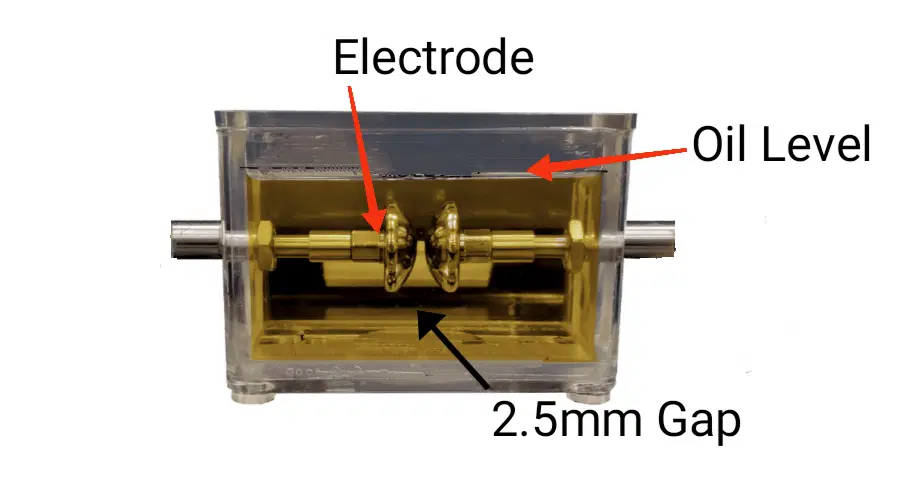The BDV test, which stands for breakdown voltage, is one of the most important test to find out dielectric strength when it comes to transformer oil.
BDV show’s the minimum voltage withstand capacity of transformer oil without breakdown.
It is performed to determine the dielectric strength of the oil, and also to detect any contaminants or other substances that could reduce its effectiveness.
BDV test is used to determine the moisture content present in oil.
The Transformer oil BDV test is a simple and straightforward process that can be performed by almost anyone with the proper equipment.
To perform a BDV test on transformer oil, a BDV testing kit is used which contains a sample container in that two electrodes are placed and separated by a 2.5mm gap
During the test, a small sample of the transformer oil is filled in a container.
An AC high voltage is applied to the electrodes, and the voltage at which the oil breaks down is measured.
This voltage reading is known as the BDV value or breakdown voltage of transformer oil.
If the BDV test is successful, it will indicate that the oil is in good condition and that it has the required electrical strength to perform its job.
As per IS 6792:1992, the minimum BDV of transformer oil as follows.
1) As per IEC, the minimum BDV of transformer oil should be 30 KV at.2.5 mm gap.
2) The BDV after oil filtration treatment should be a minimum 70 KV at a 2.5 mm gap.

Why we Perform BDV Test on Transformer Oil
Benefits of Performing a Transformer Oil BDV Test.
- BDV Test can provide a range of benefits for the user.
- By testing for breakdown voltage, you can obtain an accurate measure of the insulation quality of the oil in the transformer.
- This allows for a better understanding of the overall health of the transformer, and any potential problems that may be present.
- Additionally, the test can help to detect any contaminants that could be present in the oil, such as water and particulates.
- The test is also relatively simple, easy, and quick to perform compared to other more complex tests.
- Finally, performing the test regularly can help to ensure that the transformer remains in optimal condition, allowing it to perform efficiently over time.
Transformer oil BDV test Procedure
The procedure of transformer oil BDV testing
- Performing a BDV test is relatively simple and straightforward.
- First, you will need to obtain a sample of the transformer oil from the transformer.
- Once the sample has been taken, it is important to ensure that it is completely clean and free from any contaminants.
- Check gap between the electrode of BDV testers sample container with the help of Go or Not go gauge.
- electrode gap should be 2.5mm
- Then, the oil sample must be placed into a BDV tester.
- BDV testing kit applies high voltage that will increase gradually using an autotransformer.
- Voltage increased at the rate of 2kv/sec.
- When applied voltage reaches the value where oil breakdown occurs, we can see a spark between the electrode.
- This voltage at which the oil breakdown happens is called the BDV value of the transformer oil and its BDV should be a minimum of 30kv.
- Repeat the same procedure at least six times and note down readings and calculate an average of six readings, this will be the BDV value of the taken oil sample.
- If the dielectric strength is too low, it is likely that the transformer oil may need oil filtration.
this test can provide valuable insight into the performance and condition of a transformer, helping improve its reliability and lifespan.
